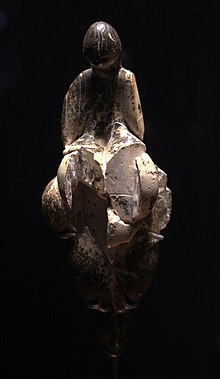Venus of Lespugue

The Venus of Lespugue is an approximately 25,000 year old Venus figurine from the Paleolithic culture of Gravettia . The statuette was discovered in 1922 by René de Saint-Périer in the Rideaux cave ( Grotte des Rideaux ) near Lespugue ( Haute-Garonne department ), a place at the foot of the Pyrenees .
description
The figure was carved from a fragment of the tusk of a woolly mammoth and is 147 mm high. During the excavation work, it was damaged in the area of the breasts and abdomen and broke into several pieces.
The fat woman is shown with a naked torso. The forearms rest on the breasts, very similar to the Austrian Venus von Willendorf . Both figurines also have in common the depiction of a hairstyle, indicated by straight engravings on Venus de Lespugue. Surface engravings that are made as vertical lines from the buttocks downwards on the back of the figure, on the other hand, are probably intended to represent clothing made of fabric. It could be a cloak that was worn around the waist. Similar, stylized textiles are also known on other Gravettian figurines: on a clay figure torso from Pavlov I (Moravia), a belt is depicted that is twisted and therefore provides an indication of the manufacture of plant fibers. Very similar ornaments show some of the contemporaneous Venus figurines from Kostenki am Don (Russia), on which braided belts are also depicted. Several Venus figurines from Malta (Russia, Siberia) have superficial patterns that are interpreted as fur clothing.
The Venus de Lespugue is now kept in the Musée de l'Homme in Paris .
Archaeological environment
The area around Lespugue is rich in sites from the Upper Paleolithic . Further excavations were carried out by Saint-Périer in the years 1924-26 in the Grotte de Gouërris , as well as in the Abri des Harpons (layers of the Solutréen ).
See also
literature
- René de Saint-Périer: Statuette de femme stéatopyge découverte à Lespugue (Haute-Garonne). L'Anthropologie XXXII, 1922, pp. 361-381
Individual evidence
- ↑ René de Saint-Périer: Statuette de femme stéatopyge découverte à Lespugue (Haute-Garonne). L'Anthropologie XXXII, 1922, pp. 361-381
- ↑ René de Saint-Périer: Les fouilles de 1923 in the grotte des Rideaux à Lespugue (Haute-Garonne). L'Anthropologie XXXIV, 1924, pp. 15-40
- ↑ René de Saint-Périer: La Grotte de Gouërris à Lespugue. L'Anthropologie 37, 1927, pp. 233-276
- ^ P. Foucher and C. San Juan: Les industries solutréennes de l'abri des Harpons et de la Grotte des Rideaux. Collections Saint-Périer des musées de Lespugue et de Saint-Gaudens. Bulletin de la Société Préhistorique Ariège-Pyrénées 55, 2000, pp. 27-33
Web links
- http://www.hominids.com/donsmaps/lespuguevenus.html
- http://www.arthistory.sbc.edu/imageswomen/lespugue.html
- Curriculum vitae and bibliography of René de Saint-Périer
Coordinates: 43 ° 14 ′ 4.6 ″ N , 0 ° 39 ′ 45.7 ″ E

